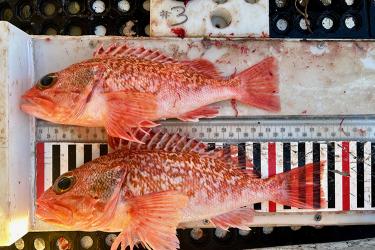The United States plans to deploy 30 gigawatts of offshore wind energy by 2030. Among the national wind energy lease areas, Southern New England waters have been experiencing rapid wind project development. Scientists at NOAA’s Northeast Fisheries Science Center are working to assess how offshore wind projects affect protected species, marine mammals, fisheries, and marine habitats.
Using Complementary Methods to Track Marine Life
With these goals in mind, Marjorie Lyssikatos, a research fish biologist with the science center’s Protected Species Division Conservation Ecology Branch and I joined forces with the Passive Acoustics Branch to collect eDNA water samples concurrently with the deployment and retrieval of passive acoustic devices. The maiden voyage for this eDNA collection was in September 2023. Marjorie and I have been going out with the passive acoustic monitoring team every 5 months ever since. Comparing the species identified by the two methods over time will allow us to document which species occupy habitats in the region both pre- and post-construction of the wind turbines planned in this area.
Marine mammals and some fish produce sound, and they also shed DNA in the ocean. This enables us to use passive acoustic monitoring and eDNA technologies to study animals we cannot see directly at sea. The Northwest Atlantic is important to many marine mammal species.
The team retrieves sound recorders for maintenance every 5 months and deploys new recorders to listen to marine mammals and some fish species for another 5 months. On these trips, Marjorie and I sample eDNA from water samples we collect, and later, other scientists provide us with the species they identified from the recorded sounds in this area.
We sample water at the surface and at the bottom because ocean stratification–natural separation of ocean water into horizontal layers of varying density–could lead to different water masses. These methods are complementary, as we can compare the enormous amount of data collected by the acoustic recorders in situ for 5 months to the periodic eDNA detections of the water column–both surface and bottom. The two types of data provide a more complete picture of the area’s biodiversity.
Filtering Water for eDNA
We deploy a traditional hydrocast setup, attaching a Seabird Conductivity, Temperature, and Depth (CTD) device and four Niskin bottles to the wire from a winch. The Seabird device measures salinity, temperature, and depth for the two bottles that sample the surface and the other two bottles that sample the bottom. Upon the retrieval of Niskin bottles back on deck, we set them in custom-built wooden frames to keep the bottles stable and upright, and start filtering. The filtration is done using a self-contained eDNA sampler, which significantly reduces the processing time otherwise needed for a vacuum filtration system. You can check out this video I made to see how we filter water from the Niskin bottles with a Smith Root eDNA sampler.
Field Operations: It Takes a Village
Our field operations would not be possible without many collaborators. Besides the science center’s Protected Species Division (both Conservation Ecology and Passive Acoustics Branches), our colleagues Tamara Holzwarth-Davis and Betsy Broughton with the Oceanography Branch have been helping us set up and troubleshoot the CTD system for collecting oceanographic data. When I was unable to sail on an expedition to a marine monument in July 2024, Lisa Guy from the Aquaculture Sustainability Branch sailed in my stead. When Marjorie had a family emergency this December, Emily Salonia from the Population Biology Branch stepped up. Crew members on the F/V Saints and Angels have also helped us increase work efficiency. For example, have I mentioned how fast they can attach and detach Niskin bottles and messengers to the wire in frigid weather, bare handed, when my hands lose dexterity due to the low temperature?! Together, we hope to carry out the time series study for as long as we are able to. The team is excited about the opportunities to conduct two novel surveys concurrently and to compare findings when we have them in a rapidly changing environment.








